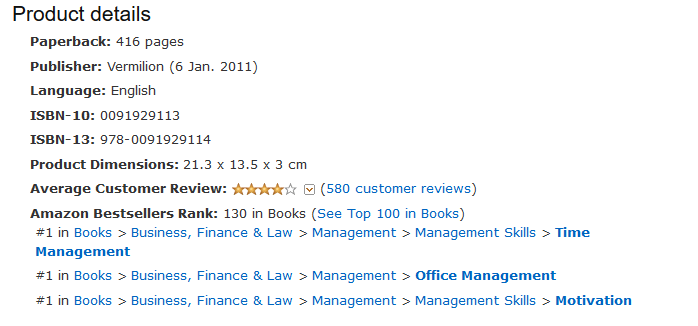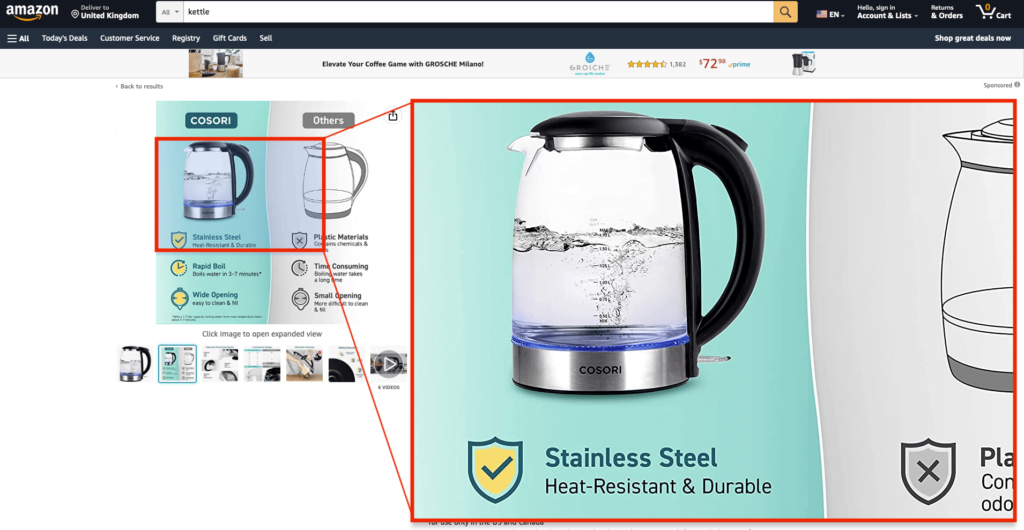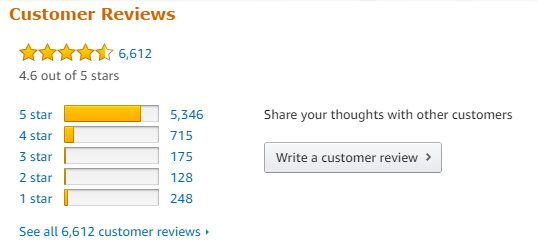Having a high product ranking on Amazon is one of the fastest ways to improve Amazon sales rank and boost visibility. A better ranking means more buyers will see your products, giving you more opportunities to make sales and grow your business.
To increase Amazon sales rank, it’s crucial to understand how Amazon’s search algorithm—known as A9—actually works.
This post will cover:
- Amazon’s Product Search Algorithm (A9)
- Core Pillars of the A9 Algorithm
- Conversion rate factors
- Relevancy factors
- Customer satisfaction and retention factors
Amazon’s Product Search Algorithm (A9)
Amazon’s search algorithm is designed with one clear goal—maximising revenue. Unlike Google’s broader focus, Amazon prioritises sales conversions. This means that how to improve sales rank on Amazon is directly tied to your ability to turn clicks into purchases.
When buyers search for a product, Amazon’s A9 algorithm first pulls relevant results from its database and then ranks them based on relevance and performance metrics.
Amazon constantly evaluates performance by using “human judgments, programmatic analysis, key business metrics and performance metrics.” Sellers who understand these factors can increase Amazon sales rank quickly.
Core Pillars of the A9 Algorithm
Amazon has three equally important ranking factors:
- Conversion rate – These include pricing, image quality, and customer reviews, which all influence sales conversions. Top tip: Tools like repricing software can help you stay competitive and improve Amazon sales rank, and to maintain a good Amazon conversion rate.
- Relevancy – Keywords, titles, and categories must match what customers are searching for to boost rankings. Amazon listing keyword optimization ensures products appear in the right searches.
- Customer satisfaction and retention – Amazon seller feedback, order defect rates and positive reviews play a big role in retaining customers and maintaining higher rankings.
Now that we’ve covered the basics, it’s time for the 21 powerful ways to increase Amazon sales rankings across your products. Warning: May lead to incredible results!
21 Amazon Product Ranking Factors
Here’s a list of 21 factors across conversion, relevance and customer satisfaction that Amazon’s A9 algorithm considers when ranking your product.
Conversion rate factors
1. Sales rank
Your Amazon sales rank (also known as the Amazon Best Sellers Rank) is a direct reflection of how well your product performs. More sales lead to a higher ranking, and a higher ranking leads to even more sales. This loop makes learning how to improve Amazon ranking essential for long-term growth.

2. Customer reviews
A higher number of positive reviews builds trust and encourages purchases. Products with better ratings are also more likely to increase Amazon sales rank and win the Buy Box.
3. Answered questions
Having plenty of answered questions at the top of your product page improves engagement because potential buyers trust that you’ll answer their questions too. Plus it also helps potential buyers make faster decisions.
4. Image size and quality

Using high-quality images (minimum 1,000 x 1,000 pixels) enables the zoom feature, which builds buyer confidence. Follow Amazon’s image guidelines carefully to avoid listing suppression and improve Amazon sales rank.
5. Price
Price influences conversions, rankings and Amazon Buy Box eligibility. Tools like RepricerExpress help sellers stay competitive and increase Amazon sales rank automatically. This is what makes it one of the most important Buy Box factors.
6. Parent-child products
By using Amazon’s parent–child product functionality you can group similar products, which consolidates reviews and boosts visibility. This means you’ll direct customers to a single product page, which can help maximise your customer reviews.
7. Time on page and bounce rate
Amazon tracks how long shoppers stay on your listing. More time signals relevance, while higher bounce rates may hurt rankings.
8. Product listing completeness
The more complete your product listing is, the better. Try to complete every single field in the listing setup page.
Relevancy factors
9. Title
The title is the first impression, so make it count! Focus on how to improve Amazon ranking by weaving in relevant keywords and keeping the title under 200 characters.
Here’s a good example directly from Amazon.

10. Features/bullet points
Highlight product features in bullet points to improve Amazon sales rank while making your listing easy to read. Detailed bullet points which include keywords (like the example below) is a great way to increase conversions.

11. Product description
Use the product description to expand on your features and include your keywords. It’s worth putting the effort into getting this right as a great product description will increase your customer engagement and conversion rates.
Likewise, a product description that isn’t up to scratch could mean you lose sales (to a competitor), or could result in negative buyer feedback. (Tip: Did you know you can remove negative feedback on Amazon?)
12. Brand and manufacturer part number
Including brand and part numbers improves discoverability, particularly for branded searches.

13. Specifications
If you’re unsure how to improve Amazon ranking, starting with accurate specifications is a quick win—what’s not to love about that!
Technical details like size, weight and material provide transparency and help buyers make informed decisions. These specifics also boost ranking by making listings more complete.
14. Category and sub-category
We can’t look at how to increase Amazon sales rank without looking at category. Simply put, selecting categories based on search behaviour can make a big difference.
Choosing the right category ensures your product appears in relevant searches and improves its chances of ranking well.
15. Search terms
Amazon gives you five fields with a character limit to specify the search terms that you want to be associated with your product. You can use Google’s Keyword Planner to help you.
Here are Amazon’s best practices for providing keywords:
- Don’t include inaccurate, misleading, or irrelevant information.
- Avoid excessively long content. Stick to the limits set for each field.
- Don’t repeat information already covered in other fields, such as the title, author, product description, bullet points, or brand.
- Enter multiple words in the most logical order when adding search terms.
- Separate keywords with a single space—no commas, semicolons, or carets needed.
- Avoid statements that are only temporarily true, such as “new,” “on sale,” or “available now.”
- Don’t use subjective claims like “amazing” or “good quality.”
- Steer clear of common misspellings of the product name.
- Don’t add variations of spacing, punctuation, capitalization, or pluralisation.
- Exclude any terms that are abusive or offensive.
- You can include abbreviations, alternate names, topics (for books, etc.) and key characters (for books or movies) as keywords.
Customer satisfaction and retention factors
16. Negative seller feedback
Negative reviews hurt rankings, so it’s essential to monitor feedback and address concerns quickly. Proactively managing complaints shows Amazon that you care about the buyer experience.
Happy customers mean repeat sales, which helps increase Amazon sales rank over time.

Related: 5 Ways to Improve Your Amazon Feedback Rating
17. Order processing speed
Fast shipping times improve satisfaction and encourage repeat purchases. Amazon tracks performance metrics closely, and sellers with faster fulfilment can rank higher.
18. In-stock rate
Going out of stock signals unreliability, which can lower rankings. Keeping products in stock consistently is a simple but effective way to improve Amazon sales rank.
19. Perfect Order Percentage (POP)
Sellers who achieve a higher percentage of perfect orders will rank higher than those who experience order issues. Learn more about POP.
20. Order Defect Rate (ODR)
If a customer makes a claim against an order, this is considered an order defect. Defects include negative buyer feedback, A-to-Z Guarantee claim, shipment problems and chargebacks.
Defects like refunds or chargebacks can push your listings down in search results. Monitoring ODR and resolving issues quickly is critical to how to increase Amazon sales rank.
Pro Tip: If the feedback is later removed by the buyer, this won’t count against your ODR. So, it’s worthwhile trying to resolve any issues that might occur. Learn how you can improve your order defect rate.
21. Exit rate
Listings that hold customer attention and encourage conversions rank higher. Optimising listings with compelling copy and visuals helps reduce exits and increase Amazon sales rank.
Don’t wait to boost your sales rankings
It might seem like a lot of work to apply all 21 points, but you’re already on the right path as you’re focusing on how to increase Amazon sales rank. Stick with it and you’ll attract more buyers and drive sales.
To improve Amazon sales rank, you need to optimise your Amazon product listings with good keywords and detailed specifications—but you also need competitive pricing.
This is where RepricerExpress makes all the difference. It makes sure your products are competitively priced constantly to maximise your sales and profits.
Even better, you can get a FREE 14-day trial right now to witness the magic for yourself. No credit cards, no bank details, no reason to wait any longer!
Source: Startup Bros
Related: 9 Tips for SEO and Keyword Research for Amazon Sellers



